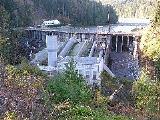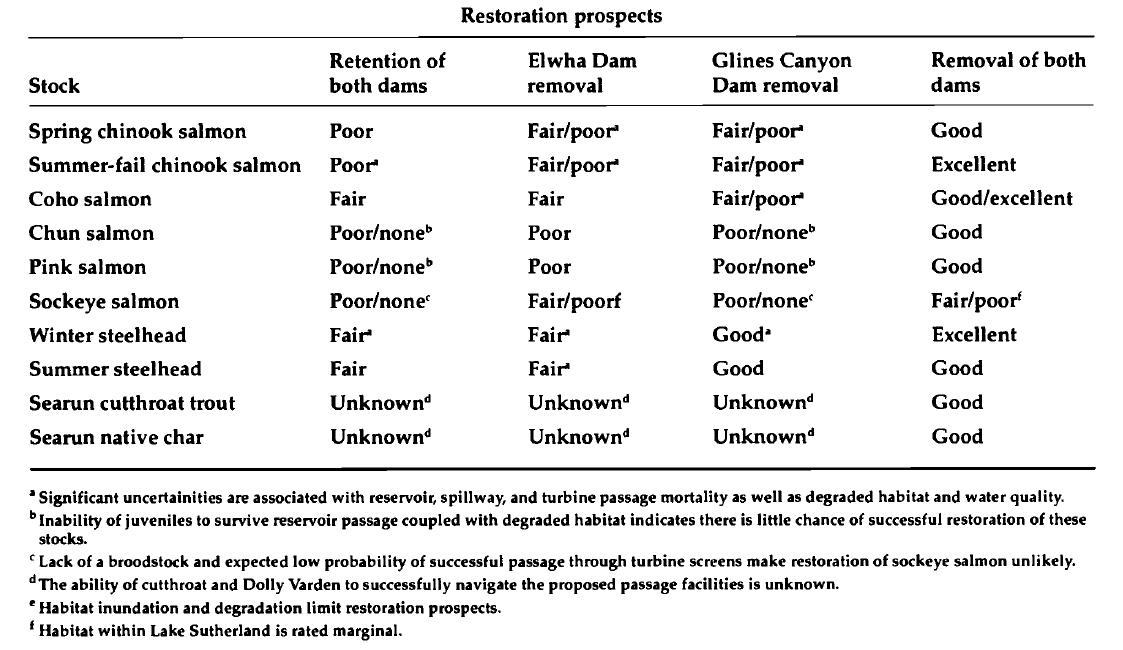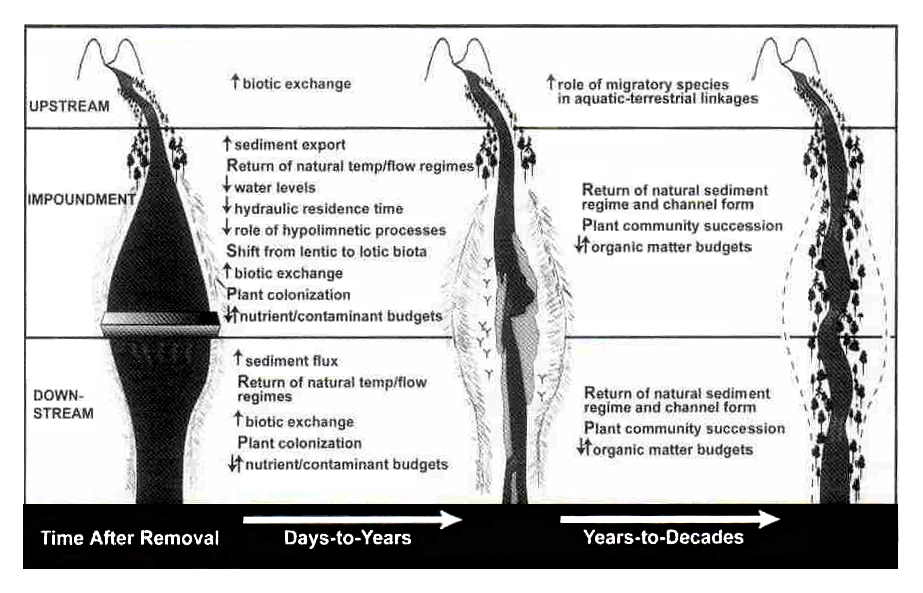
Elwha Dam
Encyclopedia
The Elwha Dam is a 108-ft (33 m) high dam located in the United States
, in the state of Washington, on the Elwha River
approximately 4.9 miles (7.9 km) upstream from the mouth of the river on the Strait of Juan de Fuca
. The dam was built under the direction of Thomas Aldwell
. Aldwell previously bought up tracts of land around the river, and with the help of Canadian financier George Glines, began construction of the Elwha Dam in 1910.
Aldwell and his contractors cut corners on constructing the dam, including not building fish passages and did not secure it to the bedrock. Thus, in 1912, as the reservoir filled behind the nearly completed dam, the lower sections of the dam gave way and a torrent of water headed downstream, taking out a bridge. Aldwell was able to get funding for reconstructing the dam and it was completed in 1913. The reservoir that fills the valley behind it is now known as Lake Aldwell
.
Initially, along with the Glines Canyon Dam
, which was completed in 1926, it helped to fuel economic growth and development for the Olympic Peninsula
and the community of Port Angeles, Washington. However, today the combined power output of both dams only provides the equivalent of 38% of the electricity needed to operate one paper mill, the Daishowa America mill.
Lacking passage for migrating salmon
, its construction blocked access by anadromous salmonids to the upper 38 miles (48 km) of mainstem habitat and more than 30 miles (48.3 km) of tributary
habitat. The salmon runs that once numbered more than 400,000 adult returns in over 70 miles (112.7 km) of available habitat, now number less than 4,000 adult returns on only 4.9 miles (7.9 km) of available habitat.
The "Elwha River Ecosystem and Fisheries Restoration Act of 1992" authorized the US Federal Government to acquire the Elwha Dam and Glines Canyon Dam hydroelectric power projects for decommissioning and demolition for habitat restoration. Work is under way on the Elwha Ecosystem Restoration
project, with actual dam removal started on September 27, 2011.
Another effect of damming is the creation of Lake Aldwell and Lake Mills. These lakes have a multitude of impacts on the river beyond sediment retention. Because the water stays in the lake for so long, it warms up to approximately 16 °C. Normal water temperatures are around 0 °C. These higher temperatures are unnatural for spawning fish, which prefer colder ocean temperature waters. This increase in temperature also increases parasite populations. Disease has been known to wipe out two thirds of a spawning population, before it has a chance to spawn. The lakes also act as buffers for high and low flow conditions. While the dams are not actively used for flood control, the reservoirs behind them alter the natural flow patterns of the river. The normal seasonal high and low flow are evened out by the reservoirs and dams so that flow is relatively constant throughout the year. Natural flow patterns are known to promote the health of native species and to help eliminate non native species after dam removal.
 At its peak, the Elwha supported spawning runs of Chinook, Coho, Chum, Pink, and Sockeye Salmon as well as Steelhead, Cutthroat, and Bull Trout. The Chinook were known to reach sizes of 45 kg. Sockeye, Chinook, Chum, and Pink Salmon are all currently thought to be extinct or nearly extinct in the Elwha. Leaving one or both of the dams in place, even with modern fish passage systems, would not result in a dramatic recovery of species due to other factors like water temperature, gravel beds, etc. which would still have negative effects on the fish species (see Table 1). The most valuable spawning habitats are located far upstream from the Glines Canyon dam, so it still acts as a major barrier to the recovery of the runs. Removal of the dams is thus considered the only viable option for full restoration of the river and habitat.
At its peak, the Elwha supported spawning runs of Chinook, Coho, Chum, Pink, and Sockeye Salmon as well as Steelhead, Cutthroat, and Bull Trout. The Chinook were known to reach sizes of 45 kg. Sockeye, Chinook, Chum, and Pink Salmon are all currently thought to be extinct or nearly extinct in the Elwha. Leaving one or both of the dams in place, even with modern fish passage systems, would not result in a dramatic recovery of species due to other factors like water temperature, gravel beds, etc. which would still have negative effects on the fish species (see Table 1). The most valuable spawning habitats are located far upstream from the Glines Canyon dam, so it still acts as a major barrier to the recovery of the runs. Removal of the dams is thus considered the only viable option for full restoration of the river and habitat.
 The Elwha River Ecosystem and Fisheries Restoration Act of 1992 created funding and government support for mitigation of the dams on the Elwha. While fish ladders were proposed as a possibility, they were ultimately ruled out for the reasons above. The major problem raised with regard to removal of the two dams is the approximately 18 million cubic yards of sediment that has built up behind the dams. Of that 18 million, 13 million is behind the Glines Canyon Dam, while 5 million is behind the Elwha Dam. Releasing all of this sediment at once would have devastating effects on the remaining habitats downstream from the dams, as well as along beaches at the coast. A drawdown experiment was conducted on the Glines Canyon Dam to assess the erosion of the sediments from Lake Mills. The lake was drawn down 18 feet (5.5 m) over one week and then allowed to remain stable for one more week. This test showed that the river would rapidly cut into the existing delta as soon as the lake level dropped, creating a deep, narrow channel. A new delta immediately began to form at the new lake level. Once the lake level was held steady, the channel migrated laterally along the existing delta. This test resulted in a sediment erosion model in which gradual drawdown of the lake would result in a greatly decreased sediment load downstream. Using this model, the plan is to drain the lake gradually over a two year time period, allowing much of the sediment to remain in the old lake basin.
The Elwha River Ecosystem and Fisheries Restoration Act of 1992 created funding and government support for mitigation of the dams on the Elwha. While fish ladders were proposed as a possibility, they were ultimately ruled out for the reasons above. The major problem raised with regard to removal of the two dams is the approximately 18 million cubic yards of sediment that has built up behind the dams. Of that 18 million, 13 million is behind the Glines Canyon Dam, while 5 million is behind the Elwha Dam. Releasing all of this sediment at once would have devastating effects on the remaining habitats downstream from the dams, as well as along beaches at the coast. A drawdown experiment was conducted on the Glines Canyon Dam to assess the erosion of the sediments from Lake Mills. The lake was drawn down 18 feet (5.5 m) over one week and then allowed to remain stable for one more week. This test showed that the river would rapidly cut into the existing delta as soon as the lake level dropped, creating a deep, narrow channel. A new delta immediately began to form at the new lake level. Once the lake level was held steady, the channel migrated laterally along the existing delta. This test resulted in a sediment erosion model in which gradual drawdown of the lake would result in a greatly decreased sediment load downstream. Using this model, the plan is to drain the lake gradually over a two year time period, allowing much of the sediment to remain in the old lake basin.
After the two year dam removal period, the river will begin to restore itself to natural conditions. Sediment discharge rates will increase, resulting in restored and rejuvenated habitats downstream from the dams. Fish will return to the upper reaches of the Elwha as quickly as a year after dam removal is complete. While the river may never return to historically large runs, after 15–20 years or more, there may be the recovery of salmon to some sort of “pre-dam” condition. In addition to restoring the fish habitats, the draining of Lake Mills and Lake Aldwell will create an additional 715 acres (2.9 km²) of terrestrial vegetation, improving elk habitats as well (Figure 1). Increased sediments loads are also predicted to help restore the retreating delta at the mouth of the Elwha.
Removal of the dams on the Elwha River has been a long, ongoing process. It appears now that the end is relatively near. Removal started on September 27, 2011 . Once the removal is complete, there is uncertainty about what exactly happens next. Because so few dam removal projects have been accompanied by scientific study, perhaps fewer than 20, this project will be a model of the effectiveness of dam removal on this scale. If it is successful, there could be a movement towards the restoration of natural stream morphology through the removal of larger dams, although the results may not be apparent for some time. Most fish populations are expected to make a return to the river (Table 1). While fish may return to the river as soon as a year after the removal is complete, it may take 15 to 20 years for the river to fully return to its pre-dam conditions. The ultimate goal of the dam removal is restoring the river to a nearly pristine state.
It has been estimated that the removal of the dams will cost $350 million.
United States
The United States of America is a federal constitutional republic comprising fifty states and a federal district...
, in the state of Washington, on the Elwha River
Elwha River
The Elwha River is a -long river located on the Olympic Peninsula in the U.S. state of Washington. From its source at Elwha snowfinger in the Olympic Range of Olympic National Park it flows generally north to the Strait of Juan de Fuca. Most of the river is contained within Olympic National Park...
approximately 4.9 miles (7.9 km) upstream from the mouth of the river on the Strait of Juan de Fuca
Strait of Juan de Fuca
The Strait of Juan de Fuca is a large body of water about long that is the Salish Sea outlet to the Pacific Ocean...
. The dam was built under the direction of Thomas Aldwell
Thomas Aldwell
Thomas Aldwell built the Elwha Dam on the Elwha River, approximate 4.9 miles upstream from the mouth of the river. Construction began in 1910 and the dam was completed in 1913. Lake Aldwell is named after him.- References :...
. Aldwell previously bought up tracts of land around the river, and with the help of Canadian financier George Glines, began construction of the Elwha Dam in 1910.
Aldwell and his contractors cut corners on constructing the dam, including not building fish passages and did not secure it to the bedrock. Thus, in 1912, as the reservoir filled behind the nearly completed dam, the lower sections of the dam gave way and a torrent of water headed downstream, taking out a bridge. Aldwell was able to get funding for reconstructing the dam and it was completed in 1913. The reservoir that fills the valley behind it is now known as Lake Aldwell
Lake Aldwell
Lake Aldwell is a reservoir located about from the mouth of the Elwha River on the Olympic Peninsula in the state of Washington. The reservoir was created in 1913 behind the Elwha Dam...
.
Initially, along with the Glines Canyon Dam
Glines Canyon Dam
Glines Canyon Dam , built in 1927, is a high concrete arch dam that forms Lake Mills upstream from the Elwha River's mouth....
, which was completed in 1926, it helped to fuel economic growth and development for the Olympic Peninsula
Olympic Peninsula
The Olympic Peninsula is the large arm of land in western Washington state of the USA, that lies across Puget Sound from Seattle. It is bounded on the west by the Pacific Ocean, the north by the Strait of Juan de Fuca, and the east by Puget Sound. Cape Alava, the westernmost point in the contiguous...
and the community of Port Angeles, Washington. However, today the combined power output of both dams only provides the equivalent of 38% of the electricity needed to operate one paper mill, the Daishowa America mill.
Lacking passage for migrating salmon
Salmon
Salmon is the common name for several species of fish in the family Salmonidae. Several other fish in the same family are called trout; the difference is often said to be that salmon migrate and trout are resident, but this distinction does not strictly hold true...
, its construction blocked access by anadromous salmonids to the upper 38 miles (48 km) of mainstem habitat and more than 30 miles (48.3 km) of tributary
Tributary
A tributary or affluent is a stream or river that flows into a main stem river or a lake. A tributary does not flow directly into a sea or ocean...
habitat. The salmon runs that once numbered more than 400,000 adult returns in over 70 miles (112.7 km) of available habitat, now number less than 4,000 adult returns on only 4.9 miles (7.9 km) of available habitat.
The "Elwha River Ecosystem and Fisheries Restoration Act of 1992" authorized the US Federal Government to acquire the Elwha Dam and Glines Canyon Dam hydroelectric power projects for decommissioning and demolition for habitat restoration. Work is under way on the Elwha Ecosystem Restoration
Elwha Ecosystem Restoration
The Elwha Ecosystem Restoration Project in the United States is the largest dam removal project in history and the second largest ecosystem restoration project in the history of the National Park Service, after the Restoration of the Everglades...
project, with actual dam removal started on September 27, 2011.
Effects of dam on river habitat
Since the construction of the dams, the lower reach of the river has seen a drastic decrease in sediment delivery. This has led to a net erosion of the river bed, including the gravels needed to create suitable habitats for spawning. Replacement gravel has been trapped in the sediment load behind the dams. These gravels are considered an essential resource for restoration of salmon habitats . The delta at the mouth of the river, where it enters the Straits of Juan de Fuca, has also seen a net erosion effect, confirmed by local tribal leaders.Another effect of damming is the creation of Lake Aldwell and Lake Mills. These lakes have a multitude of impacts on the river beyond sediment retention. Because the water stays in the lake for so long, it warms up to approximately 16 °C. Normal water temperatures are around 0 °C. These higher temperatures are unnatural for spawning fish, which prefer colder ocean temperature waters. This increase in temperature also increases parasite populations. Disease has been known to wipe out two thirds of a spawning population, before it has a chance to spawn. The lakes also act as buffers for high and low flow conditions. While the dams are not actively used for flood control, the reservoirs behind them alter the natural flow patterns of the river. The normal seasonal high and low flow are evened out by the reservoirs and dams so that flow is relatively constant throughout the year. Natural flow patterns are known to promote the health of native species and to help eliminate non native species after dam removal.
History of the Elwha fishery

Dam removal

After the two year dam removal period, the river will begin to restore itself to natural conditions. Sediment discharge rates will increase, resulting in restored and rejuvenated habitats downstream from the dams. Fish will return to the upper reaches of the Elwha as quickly as a year after dam removal is complete. While the river may never return to historically large runs, after 15–20 years or more, there may be the recovery of salmon to some sort of “pre-dam” condition. In addition to restoring the fish habitats, the draining of Lake Mills and Lake Aldwell will create an additional 715 acres (2.9 km²) of terrestrial vegetation, improving elk habitats as well (Figure 1). Increased sediments loads are also predicted to help restore the retreating delta at the mouth of the Elwha.
Removal of the dams on the Elwha River has been a long, ongoing process. It appears now that the end is relatively near. Removal started on September 27, 2011 . Once the removal is complete, there is uncertainty about what exactly happens next. Because so few dam removal projects have been accompanied by scientific study, perhaps fewer than 20, this project will be a model of the effectiveness of dam removal on this scale. If it is successful, there could be a movement towards the restoration of natural stream morphology through the removal of larger dams, although the results may not be apparent for some time. Most fish populations are expected to make a return to the river (Table 1). While fish may return to the river as soon as a year after the removal is complete, it may take 15 to 20 years for the river to fully return to its pre-dam conditions. The ultimate goal of the dam removal is restoring the river to a nearly pristine state.
It has been estimated that the removal of the dams will cost $350 million.

